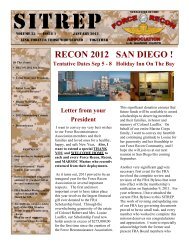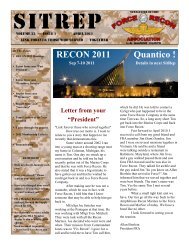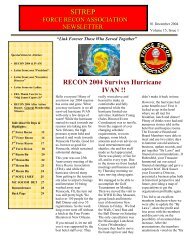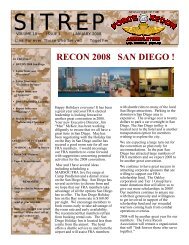Det One - Force Recon Association
Det One - Force Recon Association
Det One - Force Recon Association
You also want an ePaper? Increase the reach of your titles
YUMPU automatically turns print PDFs into web optimized ePapers that Google loves.
Training 37<br />
Photo courtesy of Patrick J. Rogers<br />
<strong>Det</strong> <strong>One</strong>’s armorer, GySgt Mark S. Kitashima, conducts<br />
instruction on the M2 .50-caliber heavy machine<br />
gun during the Capstone Exercise, at Mercury,<br />
Nevada, in December 2004.<br />
knew its business individually and collectively from<br />
several years of deployments. It was also a platoon<br />
loaded with close-quarters battle instructors: Master<br />
Sergeant Oakes and Gunnery Sergeant Morrison, to<br />
name only two, had spent time as special operations<br />
training group shooting instructors. All were experienced<br />
marksmen and tacticians, giving them the right<br />
foundation to rapidly achieve a higher level of proficiency.<br />
But they were about to be challenged to<br />
begin thinking critically about how they needed to<br />
conduct their operations.<br />
In order to break away from the Marine Corps<br />
close quarters combat model, the detachment contracted<br />
directly for the services of a retired U.S. Army<br />
Special <strong>Force</strong>s soldier, a veteran of a tier-one Special<br />
Operations Command unit. He first observed them as<br />
they breached and cleared a structure. He did not like<br />
what he saw and told the Marines that what they<br />
were doing was not going to cut it against the opponents<br />
they would be facing. The new set of tactics<br />
and techniques he taught them was “vastly different<br />
from what we did, as Marines, up to this point,” said<br />
Captain Thompson. He called the experience “very<br />
enlightening.” 24 No substantial change is easy, and<br />
not all of the Marines immediately embraced the new<br />
methods.<br />
Staff Sergeant Alex N. Conrad, one of the reconnaissance<br />
scouts, described the difficult but constructive<br />
change. The instructor “taught us what we<br />
needed to do,” but then “we went into the house [the<br />
specially constructed building for live-fire close quarters<br />
battle training], and we reverted back to our old<br />
tactics.” Conrad remembered that the retired Special<br />
<strong>Force</strong>s soldier yelled “‘stop, stop. Stop right there.’<br />
He just told us, ‘this is not going to work. Here’s what<br />
we’re going to do, and this is how we’re going to do<br />
it. Get back out of the house and re-do this, one thing<br />
at a time.’” He told them bluntly that their old tactics<br />
were going to get them killed. When he demonstrated<br />
how their methods were slower and less effective<br />
than his—by having some Marines watch from<br />
a gallery in the house while the others went through<br />
the problem using both ways—he got his point<br />
across. 25 Conrad credits him with engineering a complete<br />
reversal in the reconnaissance element’s tactical<br />
mindset. “He changed our way of thinking. I think<br />
that was the turning point.” 26<br />
The main issue the experience highlighted, and<br />
the one that cut to the essence of the larger<br />
USMC/SOCom relationship, was the divergence of<br />
Marine Corps close quarter battle tactics with those<br />
used by the upper-tier SOCom units. “Basically,” said<br />
Master Sergeant Padilla, “we were using dinosaur tactics.”<br />
27 The big switch was a change from their familiar<br />
“initiative-based tactics” to the more fluid and dynamic<br />
“team-based tactics.” Initiative-based tactics<br />
relied on a single point of entry into a target house.<br />
Team-based tactics, on the other hand, enabled the<br />
Marines to simultaneously hit that target from more<br />
angles, then flow rapidly from room to room, maintaining<br />
the speed, shock, and violence of action they<br />
needed to gain the upper hand and prevail.<br />
The new tactics prompted a structural change in<br />
the detachment. The reconnaissance platoon reorganized<br />
from four teams of seven Marines each to six<br />
teams of four or five Marines each. Staff Sergeant Jack<br />
A. Kelly, assistant team leader in Master Sergeant<br />
Terry M.Wyrick’s Team 1, and Gunnery Sergeant Sidney<br />
J. Voss from Gunnery Sergeant Dailey’s Team 4<br />
became the leaders of Teams 5 and 6. (Although the<br />
detachment received no new corpsmen to fill out the<br />
new structure, the platoon had enough certified<br />
emergency medical technicians—Staff Sergeant Kelly<br />
being one of them—to cover the basic requirements.)<br />
The introduction of team-based tactics to <strong>Det</strong><br />
<strong>One</strong>’s reconnaissance element was more of a significant<br />
single addition to its toolbox than a wholesale<br />
replacement. Some of the younger Marines in the platoon<br />
took to team-based tactics more readily than the<br />
older ones and saw it as a day-and-night change, but<br />
the more wily and seasoned among them adopted a<br />
comprehensive view. Master Sergeant Wyrick pointed<br />
out later that most of the detachment’s direct action<br />
missions in Iraq were conducted using individual-






